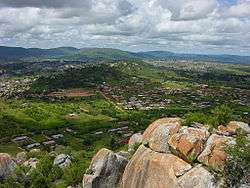Please tell us which country and city you'd like to see the weather in.
Iringa Rural District
Iringa Rural District (Wilaya ya Iringa Vijijini) is one of the four districts of the Iringa Region of Tanzania, East Africa. It is bordered to the north by the Dodoma Region, to the east by Kilolo District and encircles Iringa Urban District, to the south by the Mufindi District, to the southwest by the Mbeya Region and to the northwest by the Singida Region.
As of 2002, the population of the Iringa Rural District was 245,623.
Wards
As of 2002, Iringa Rural District was administratively divided into twenty wards:
Notes
Coordinates: 7°46′09″S 35°42′11″E / 7.7693°S 35.7030°E / -7.7693; 35.7030

Iringa
Iringa is a city in Tanzania with a population of 112,900 (as of 2004). It is situated at a latitude of 7.77°S and longitude of 35.69°E. The name is derived from the Hehe word lilinga, meaning fort.
Iringa is the administrative capital of Iringa Region. It has many established industries, including manufacturing and food processing. Most of its electricity comes from the nearby Mtera Dam. Iringa is a minor transport hub, with regular bus service and trucking to Dar es Salaam, Mbeya, Songea, and Dodoma.
History
Iringa was built during the 1890s by the German Army as a defensive base to be used against the Hehe uprising led by Chief Mkwawa. The fortress and headquarters of Chief Mkwawa was situated in the nearby village of Kalenga. The town stretches along a hilltop overlooking the Ruaha River to the south, and spreads along ridges and valleys to the north. The altitude of the town's environs is more than 1,550 metres (5,090 ft) above sea level. The months of June, July, and August can see low temperatures near freezing. The Tanzam Highway passes through the valley below the town; the highway distance from Iringa's limits to Dar es Salaam is 502 kilometers (312 mi), via Morogoro. The Isimila Stone Age site, which lies about 20 km (12 mi) to the southwest, contains archeological artifacts, particularly stone tools, from human habitation about 70,000 years ago.

Iringa Region
Iringa is one of Tanzania's thirty administrative regions. The regional capital is Iringa. Prior to 2012 the total area was 58,936 square kilometers (22,755 sq mi), of which land area was 56,864 km sq (21,955 mi sq) and water area was 2,070 km² (800 mi sq); however Iringa lost its three southern districts and considerable area in the creation of Njombe Region.
The former Iringa Region had a population of 1,495,333, according to the 2002 census. The currently sized Iringa, the four old northern districts, had a combined population of 840,404 in the 2002 census.
Iringa Region is home to Ruaha National Park, Tanzania's second largest park, which has an abundance of wildlife and approximately 7,500 visitors per year. A second park, Udzungwa Mountains National Park in Iringa Rural District, is less visited.
The Regional Commissioner of the Iringa Region is Christine G. Ishengoma.
Districts
The region is administratively divided into three districts:
References
Coordinates: 9°00′S 35°00′E / 9.000°S 35.000°E / -9.000; 35.000
Podcasts:

